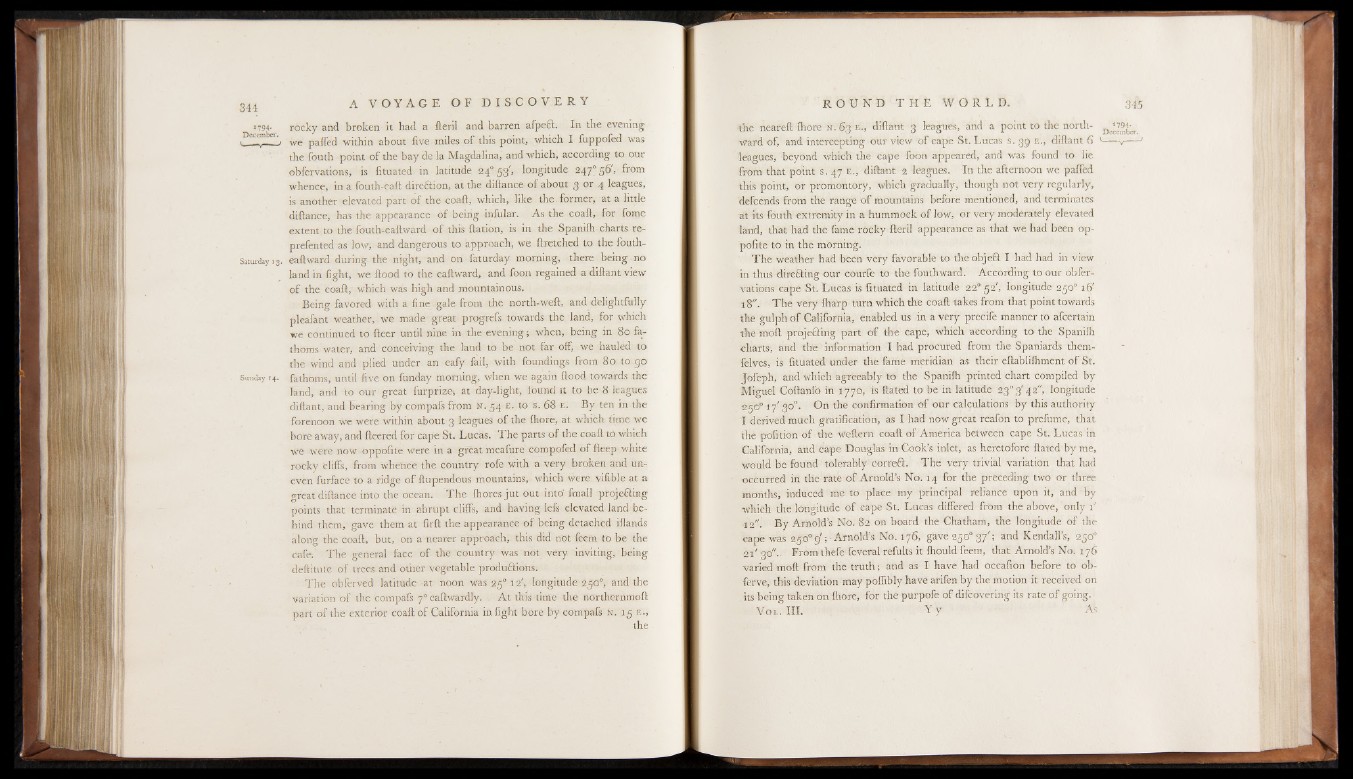
>794- rocky and broken it had a fteril and barren afpect. In the evening
i - _ i we parted within about five miles of this point, which I fuppofed was
the fouth point of the bay de la Magdalina, and which, according to our
obfervations, is fituated in latitude 240 53’, longitude 2470 56, from
whence, in a fouth-eaft direction, at the diftance of about 3 or 4 leagues,
is another elevated part of the coaft, which, like the.former, at a little
diftance, has the appearance of being infular. As the coaft, for fome
extent to the fouth-eaftward of this ftation, is in the Spanilh charts re-
prefented as low, and dangerous to approach, we ftretched to the fouth-
Saturday 13. eaftward during the night, and on faturday morning, there being no
land in fight, we flood to the eaftward, and foon regained a diftant view
of the coaft, which was high and mountainous.
Being favored with a fine gale from the north-weft, and delightfully
pleafant weather, we made great progrefs towards the land, for which
we continued to fleer until nine in the evening; when, being in 80 fathoms
water, and conceiving the land to be not far off; we hauled to
the wind and plied under an eafy fail, with foundings from 80 to go
Sunday 14. fathoms, until five on funday morning, when we again flood towards the
land, and to our great furprizei at day-light, found it to be 8 leagues
diftant, and bearing by compafs from N . 54 e . to s . 68 e ; By ten in the
forenoon we were within about 3 leagues of the Ihore, at which time we
bore away, and fleered for cape St. Lucas. The parts of the coaft to which
we were now -oppofite were in a great meafure compofed o f fteep white
rocky cliffs, from whence the country rofe with a very broken and uneven
furface to a ridge of ftupendous mountains, which were vifible at a
great diftance into the ocean. The Ihoresjut out into fmall projecting
points that terminate in abrupt cliffs, and having lefs elevated land behind
them, gave them at firft the appearance of being detached illands
along the coaft, but, on a nearer approach, this did not feem to be the
cafe.' The general face of the country was not very inviting, being
deftitute of trees and other vegetable productions.
The obferved latitude -at noon was 25° 12', longitude 250°, and the
variation of the Compafs 70 eallwardly. . At this-time the northernmoft
part of the exterior coaft of California in fight bore by compafs n . 15 e . ,
the
the neareft Ihore n. 63 e., diftant 3 leagues, and a point to the northward
of, and intercepting our view of cape St. Lucas s. 39 e., diftant 6 1
leagues, beyond which the cape foon appeared, and was found to lie
from that point s. 47 e., diftant 2 leagues. In the afternoon we parted
this point, or promontory, which gradually, though not very regularly,
defcends from the range o f mountains before mentioned, and terminates
at its fouth extremity in a hummoek of low, or very moderately elevated
land, that had the fame rocky fteril appearance as that we had been op-
pofife to m the morning.
The weather had been very favorable to the objeft I had had in view
in thus direHing our couffe to the fouthward. According to our obfervations
cape St. Lucas is fituated in latitude 22* 52', longitude 250° 16'
18".' * The very fharp turn which the coaft takes from that point towards
the gulphof California, enabled us in a very precife manner to afcertain
the moll projecting part of the cape, which according to the Spanilh
charts, and the information I had procured from the Spaniards them-
felves, is fituated under the fame meridian as their eftablilhment of St.
Jofeph, and which agreeably to the Spanilh printed chart compiled by
Miguel Coftanfo in 1770, is ftated to be in latitude 23" 3'42", longitude
250“ 17' 30". On the confirmation of our calculations by this authority
I derived much gratification, as I had now great reafon to prefume, that
the pofition of the weftern coaft of America between cape St. Lucas in
California, and Cape Douglas in Cook’s inlet, as heretofore ftated by me,
would be found tolerably correft. The very trivial variation that had
occurred in the rate of Arnold’s No. 14 for the preceding two or three
months, induced me to place my principal reliance upon it, and by
which the longitude of cape St. Lucas differed from the above, only T
12". By Arnold’s No. 82 on board the Chatham, the longitude of the
cape was 256° 9 ' Arnold’s No. 176, gave 250° 37'; and Kendall’s, 250°
21' 30".. From thefe feveral refults it lhould feem, that Arnold’s No. 176
varied moft from the truth; and as I have had occafion before to ob-
ferve, this deviation may poflibly have arifen by the motion it received on
its being taken on Ihore, for the purpofe of difcovering its rate of going.
V o 1. III. V y As